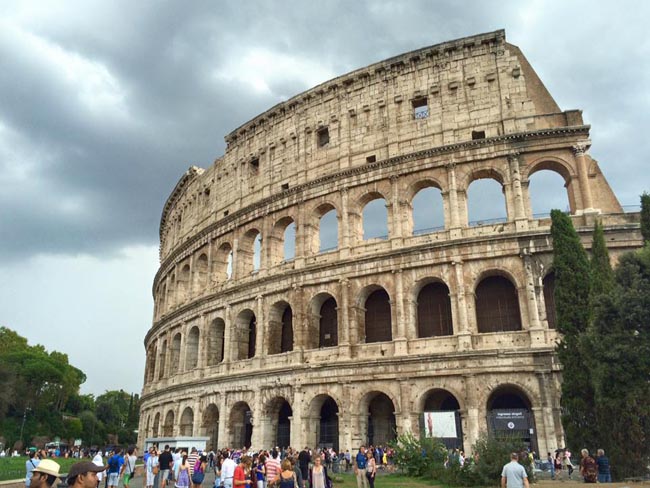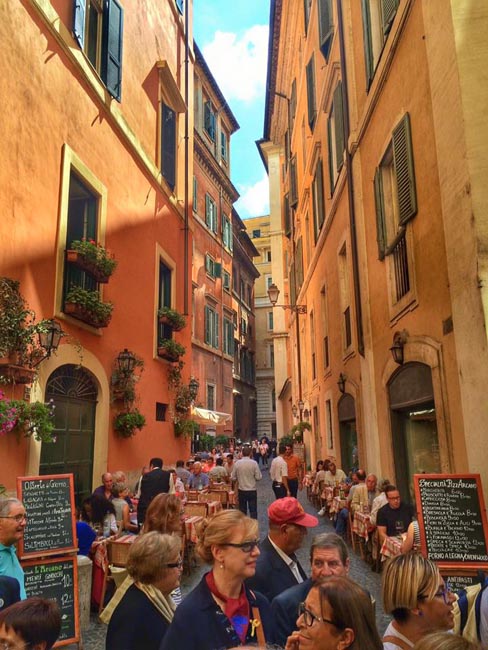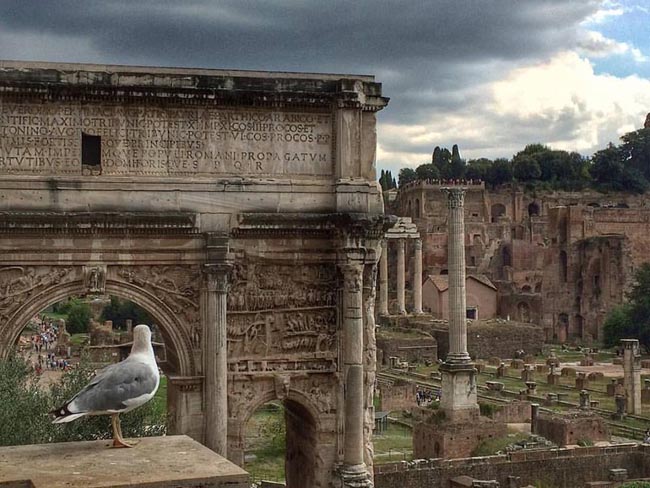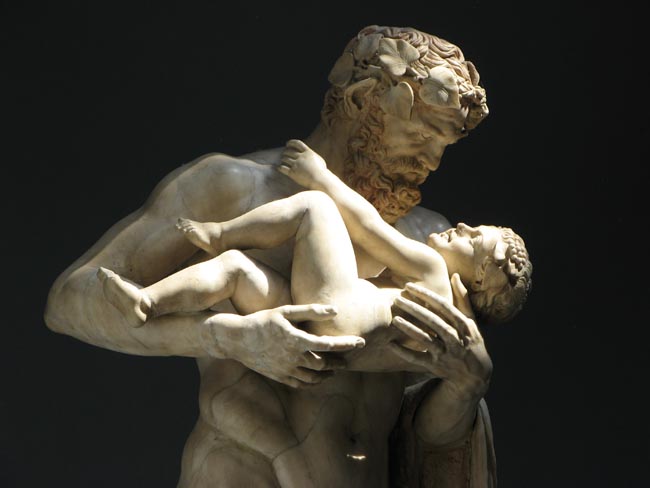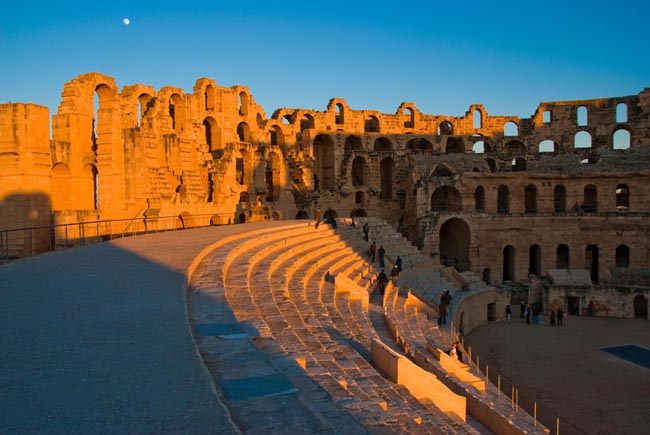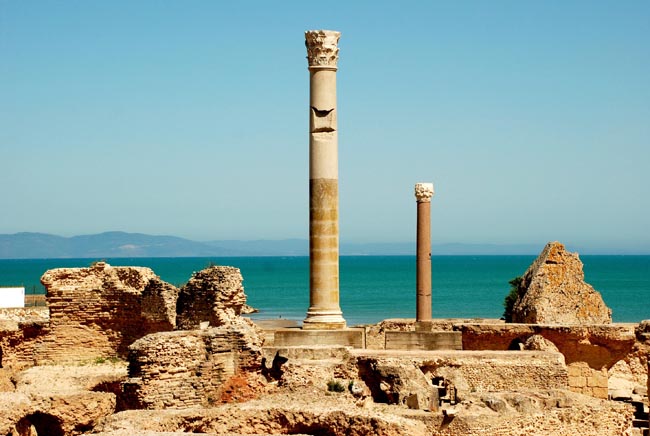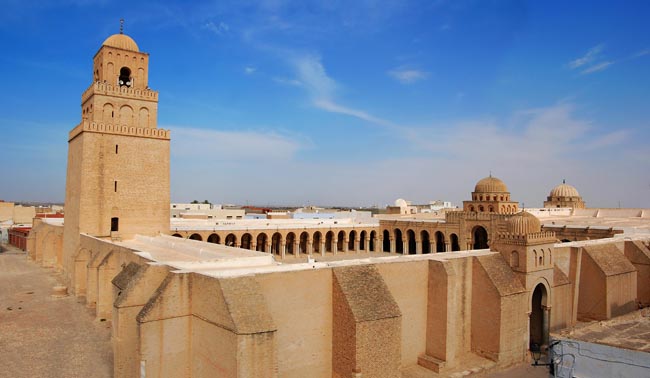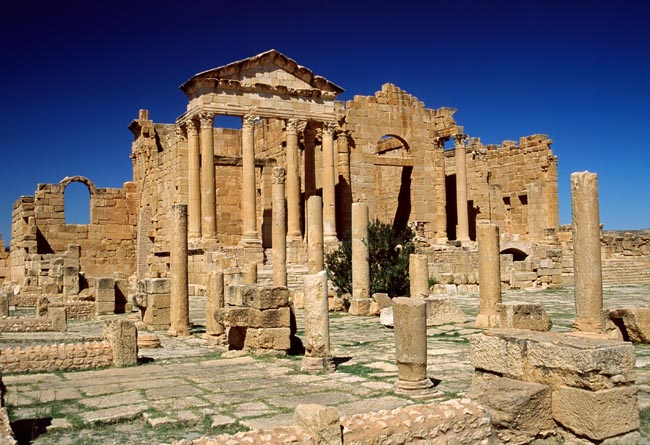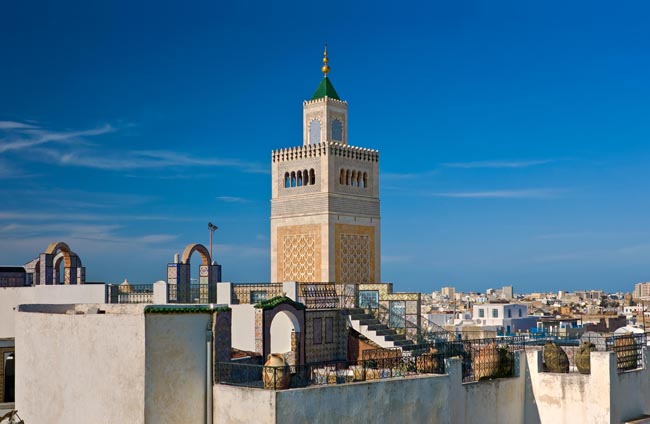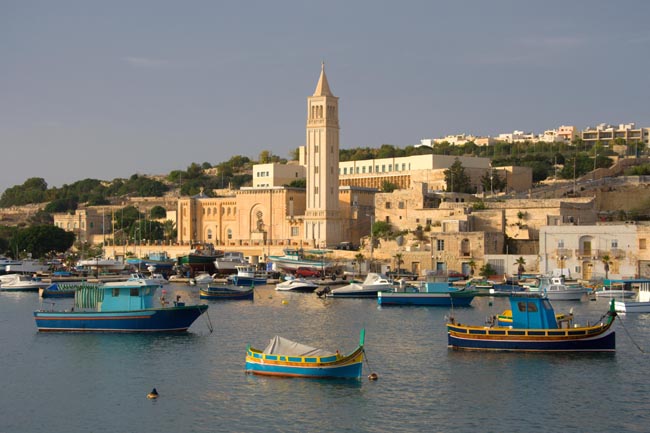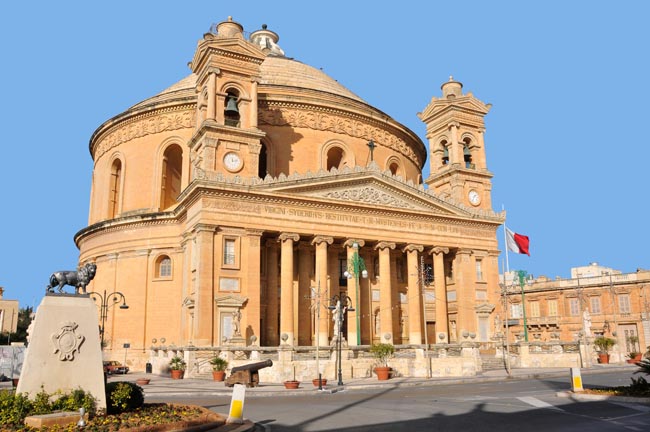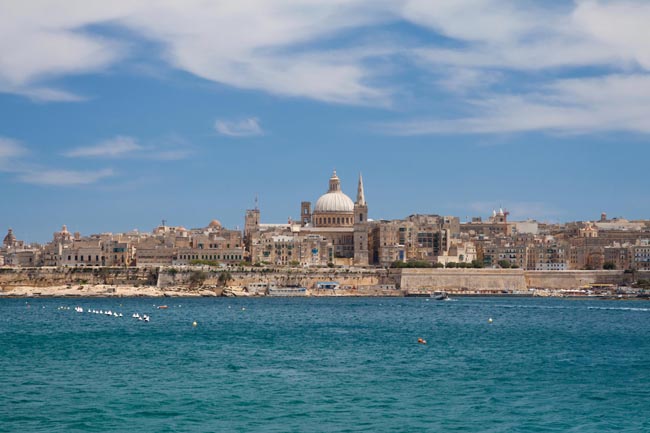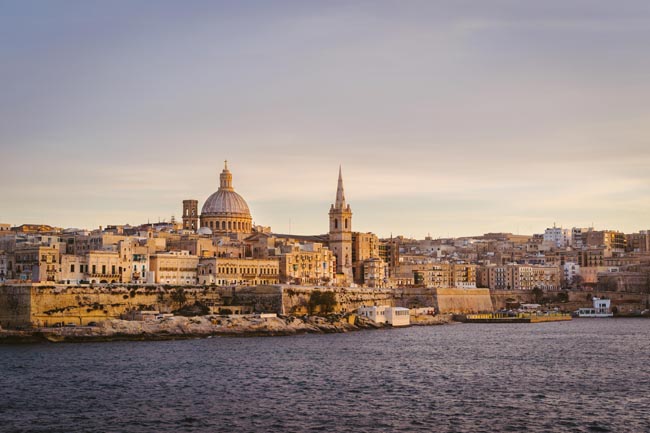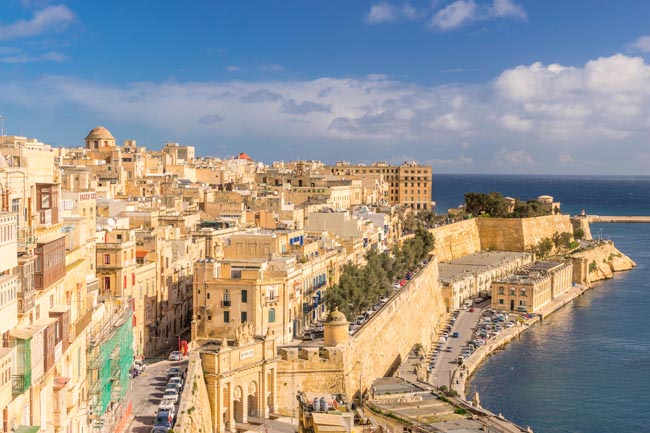This Tunisia, Malta & Italy Tour gives us a good perspective of the considerable expanse of the Roman Empire.
From the Byrsa Hill acropolis along the Tunisian shores of Carthage, to the massive ceiling of the Sistine Chapel in Vatican City, the wealth and influence of this empire shows us why it had such great influence over the history of the Mediterranean.
The many museums throughout the tour give us valuable insight into the lives of ancient civilizations and a pleasant stroll through the preserved village of Pompeii offers a personal approach to the past.
Impressive temples, once dedicated to Greek gods, leave lasting impressions no matter what locale serves as their backdrop, be it Malta, Italy or Tunisia.
See how the imperfections of cobblestone streets throughout Sicilian villages are endearing attributes, or how the steep slopes of Malta give a unique quality to the structures built on them.
Prices below are per person, twin-sharing costs in US Dollars (USD). Pricing does not include airfare to/from the tour and any applicable taxes. For single supplement rates and taxes (if any), please refer to below Prices & Dates table. For general information on flights to/from the tour, click here.
Select a date below to reserve your spot:
The above prices are subject to an additional $120 for taxes/fees levied on flights that occur as part of the tour. The internal airfares ARE included (any exceptions are listed in red below), but we list the taxes separately on your invoice as they are beyond our control and can change at any time.
This tour will not be offered in 2022, but will resume once again from 2023 onward.
Optional Single Supplement: $1910 USD (number of singles limited).
This tour may require a mandatory single supplement charge of $960 if you join our share program and we are unable to pair you.
Download Itinerary
Day 1 Arrive in Tunis
Arrival in Tunis.
Tunis, the capital of the country, is a bustling metropolis and the home of one-sixth of the country’s population. Situated in the Gulf of Tunis on the Mediterranean Sea, the modern city extends along the coastal plains and to the surrounding hills. It is a city of many contrasts, with its modern office buildings, shopping malls and European cafes, the colonial French style of the Ville Nouvelle, and the dynamic Arab souks of Tunis' old Medina.
Overnight in Tunis.
Included Meal(s): Dinner
Day 2 Tunis: The Medina, Bardo Museum, Sidi Bou Said & Carthage
We begin the day with a walking tour through one of two UNESCO sites we visit today (two of the eight in the entire country) -- the old medina of Tunis with its narrow lanes crowded with mosques, tombs, and palaces. This was Tunis until the arrival of the French in the late 19th century, who subsequently built their quarters outside of the "Sea Gate" -- now the Ville Nouvelle. En route we will see the Great Mosque of Tunis, Jemaa Zitouna, and the elegant Place du Gouvernement.
We then visit the Bardo Museum, which houses the largest and finest collection of ancient mosaics in the world. These mosaics were discovered in the wealthiest of Roman villas in the many ancient cities found in Tunisia. Rich patrons commissioned a vast array of subjects and themes, from scenes of gods and goddesses, daily life (hunting, fishing, harvesting), the zodiac, seasons, amphitheatre games. From their exquisite details, we can understand why the North African school of mosaicists was the finest in the ancient world, and whose masterpieces can be found throughout the Mediterranean.
We then head to Sidi Bou Said, a charming hilltop village famous for its beautifully decorated blue and white architecture. Visited by the likes of Cervantes, Simone de Beauvoir and Jean Foucault, Sidi Bou Said made an indelible impression on the works of Paul Klee, August Macke and Louis Moilliet who stayed here together in 1914. You will have some free time for lunch and to explore this beautiful village overlooking the Mediterranean Sea.
We continue to Carthage – the legendary city of Queen Dido and Hannibal (today's second UNESCO site ). We will begin with a visit to the ancient Punic cemetery -- the Tophet, or sanctuary to Baal and Tanit. Roman propaganda, hostile to their enemy, stated that the Carthaginians ritually sacrificed their children here to the gods. Our next stop is the Punic ports, once the foundation of Carthage's prosperity. Here we see the remains of what was once a sophisticated naval harbour, complete with ship sheds for dry-docking their warships, and a elaborate merchant harbor, for their fleets of cargo ships which engaged in trade throughout the Mediterranean. From here we visit Byrsa hill -- the ancient acropolis and the first area to be settled by the Phoenicians. Crowning the hill is the 19th century Cathedral of St. Louis and the Carthage museum with finds excavated from the city. Our final stop is the Antonine Baths -- the monumental public baths of the city. In the 2nd century AD, these were the largest baths in North Africa and the 3rd largest in the Roman world.
Overnight in Tunis.
Included Meal(s): Breakfast and Dinner
Day 3 Tunis - Bulla Regia & Dougga - Tunis
We leave Tunis early this morning for Bulla Regia. This ancient site is famous for its unique subterranean villas, which belonged to the wealthiest of its inhabitants; we descend to see these luxurious villas and their splendid floor mosaics, still in situ.
After lunch we continue to Dougga, the best-preserved Roman city in Tunisia and a UNESCO World Heritage Site. The monumental Capitolium temple stands in the city's Forum, with a breathtaking view over the green rolling hills and plains below. The theaters, gymnasia, baths, shops, stone paved streets and lavish villas are all testimony to the golden age this North African city enjoyed during the Roman era.
Overnight in Tunis.
Included Meal(s): Breakfast and Dinner
Day 4 Tunis - Kairouan: City Touring
This morning we head to Kairouan, travelling through the fertile valleys and rolling hills of the North. Since antiquity to the present, Tunisia is still referred to by other Maghreb countries by the epithet, "Tunisia the Green." This area is a favorite haven for storks, who build their nest on top of telephone towers, minarets and rooftops. We head toward into the Sahel, the transitional barren region between the fertile north and the Sahara desert to the south.
The Holy City of Kairouan is not only the spiritual center of Tunisia, it is the first Islamic city to be established in North Africa, and the 4th oldest Muslim city outside of Arabia. Founded as the capital of the region in 670 AD by the Arab general Oqba ibn Nafi, Kairouan soon acquired magnificent ramparts, mosques, palaces and hammams. Our first stop is the Aghlabid basins, enormous artificial reservoirs constructed in the 9th century to store water for Kairouan, as part of a monumental system in which water was brought by aqueducts to the city from 36km away.
We visit the Great Mosque of Kairouan, the oldest, largest and most important mosque in Tunisia. The lowest story of the towering minaret is thought to date to 730 AD, one century earlier than the structure of the present mosque. Inside we will see the colonnaded courtyard with its ancient wellheads and sundials, and the forest of columns of the prayer sanctuary. The hundreds of columns all differ from one another, in marble types, size, shape and capital designs, since most were taken from ancient Roman sites and reused in the mosque's construction. Our final stop before leaving Kairouan is the Mausoleum of Sidi Sahab, also known as the Mosque of the Barber.
We finish our day with a walking tour of old medina of Kairouan -- the entire medina is protected by UNESCO. Meandering through the lanes, we will stop to admire the beautiful traditional doors and architectural styles, the main monuments, markets, pastry shops and traditional workshops.
Overnight in Kairouan.
Included Meal(s): Breakfast and Dinner
Day 5 Kairouan - Sbeitla - Tozeur
We continue to the spectacular Roman city of Sufeitula -- modern Sbeitla. The Roman civic center is incredibly photogenic, due to the excellent state of preservation its three monumental temples dedicated to Juno, Jupiter and Minerva towering over the Forum. Sbeitla, like other North African cities, prospered in the 2nd and 3rd centuries AD under the Pax Romana. Upon entering the site, we will see olive press -- one of many in the city, since the inhabitants here became extremely wealthy from the trade of olives and olive oil. After visiting the forum and its temples, we will walk through Sbeitla's stone paved streets to see the public baths, the theater, and numerous Christian basilicas with their elaborate baptisteries covered in colourful mosaics.
Heading south, we arrive in the late afternoon at the fascinating oasis town of Tozeur. In medieval times, Tozeur was an important cultural and market center, due to its strategic location on the caravan routes. Merchants from North and West Africa gathered in this thriving oasis, trade such goods as wool, dates, gold, ivory, salt and slaves. Some of the finest dates of the world are grown in the region, the deglat nour or "finger of light". Medieval accounts state that over 1,000 camels used to leave here per day, laden only with dates!
On arrival we will visit the palmerie to view the various crops being grown and to absorb the oasis atmosphere.
Overnight in Tozeur.
Included Meal(s): Breakfast and Dinner
Day 6 Tozeur - Douz - Matmata - Djerba
Our journey continues eastwards across Chott El Jerid, Tunisia's largest salt lake, extending over 5,000km2. The chott lies 30m below sea level, and is a remnant from over 1.5 million years ago when the area was flooded by the sea. Water on the surface of the salt floor reflects strange hues of pink and yellow, and the refraction of light on this depression often creates mirages.
Our next stop is Douz, the "Gateway of the Sahara", another ancient oasis town surrounded by vast expanses of sand dunes. The final leg of our journey takes us to the legendary island of Djerba, where we will spend the first of two nights. Our drive takes us through one of the main olive growing regions of the country; Tunisia has over 65 million olive trees (6 for each inhabitant!) and is currently the 4th largest exporter of olive oil in the world.
We stop at Matmata, where the inhabitants live in rock-hewn dwellings ("troglodyte" homes), some of which are over 400 years old. We will visit the pit dwelling of a local family who will happily show us around. We will also stop to see the cave home which appeared in the first Star Wars film (1977) and was later converted into Hotel Sidi Driss.
Overnight in Djerba.
Included Meal(s): Breakfast and Dinner
Day 7 The Isle of Djerba
We will spend the morning exploring the sites of this splendid island, the country's most recently-named UNESCO site. Originally settled by the Phoenicians, the isle of Djerba is the mythical place where Odysseus encountered the Lotus Eaters during his journey back home from Troy. Phoenicians, Greeks, Romans, Vandals, Normans, Arabs, Spaniards, and Ottoman Turks -- all have come to Djerba and left their footprint. Historically Djerba has been known for its sponge fishing and agriculture -- here we can find olive trees which are over 1000 years old. The island today is one of Tunisia’s most famous resorts, with its small villages, charming towns, and 125 km of sandy beaches. Today’s inhabitants of Djerba are culturally distinct from mainland Tunisians, and are proud of their customs, dress and dialect.
Our first visit is the excellent ethnographic Museum of Patrimonie, which celebrates the island’s peoples and traditions. Here we will see displays of marriage festivals and traditional wedding dresses from various parts of the country, traditional costumes of the island, circumcision ceremonies, household and agricultural implements, and displays of typical arts of weaving, calligraphy, jewelry and metalwork. We proceed to the center of Guellala, the pottery producing center of the island where we stop to see the kilns and workshops. Next is El Ghriba ("The Miracle") synagogue: one of the oldest synagogues and most important Jewish pilgrimage sites in the world. Djerba is home to one of the world’s most ancient Jewish communities: tradition states that they arrived here after the First Destruction of the Temple by Nebuchadnezzar in 566 BC. This holy synagogue is fascinating for its historic and spiritual importance, as well as for its distinctive style of architecture (a marvelous blend of Jewish, Tunisian, Maghrebian and Sephardic elements). We proceed to the main town Houmt Souq, where first we shall stop to see the medieval fort, Borj el Kebir; this was the scene of a bloody conflict in 1560 between the forces of Dragut, the Barbary corsair, and Philip II of Spain. In town, we will explore the fruit and vegetable markets, watch the excitement at the daily fish auctions, and wander the narrow lanes and souqs. You will have free time to explore more of this charming town, perhaps do some shopping and have lunch at one of the many restaurants in the center.
The rest of the afternoon is at leisure. You may wish to stay in Houmt Souq, go to the beach, or relax at the hotel.
Overnight in Djerba.
Included Meal(s): Breakfast and Dinner
Day 8 Djerba - Sfax
Our drive continues to the coastal city of Sfax where we arrrive in time for a walk though the medina. This is the second largest city in Tunisia; today Sfax a major commercial and manufacturing centre (mainly of olive oil, almonds, phosphates and textiles) with very little tourism. Inside the massive 9th century ramparts of the old walled city, is the country's finest "living and working" medina.
On arrival we'll walk through the medina of Sfax; part of the Blacksmith's souq was featured in the film, 'The English Patient.' We will do a walk through the historic lanes, markets and workshops before continuing inland to El Djem (ancient Thysdrus).
Overnight in Sfax.
Included Meal(s): Breakfast and Dinner
Day 9 Sfax - El Djem - Monastir - Tunis
Today we travel to the impressive site of El Djem, the final UNESCO site featured on our tour.
Our first El Djem visit is the excellent Archaeological Museum, with its splendid collection of floor mosaics from the villas of the wealthiest inhabitants of El Djem. Just behind the museum is the House of Africa, an opulent villa covering over 3000 sq m which was found in the center of town, dismantled and moved here in its entirety. The villa is named after one of its excellent fine floor mosaics depicting the Goddess of Africa (the only mosaic of its kind in the world).
The sudden appearance of the massive Roman Amphitheatre is an extraordinary sight. With a capacity of 30,000 spectators, it rises 3 stories above the surrounding plains -- though smaller than the Colosseum in Rome, it is in many ways more impressive due to its excellent state of preservation. It was built during the reigns of the (usurper) Emperors Gordion I and his son, Gordian II, both of whom reigned for only a few weeks before being defeated by the legions sent from Rome. Wild beast fights, gladiatorial combats, circuses and games were held here. We climb up to the upper tiers for excellent views of the arena and surrounding countryside, before descending to the basement to see the chambers where scenery, gladiators, prisoners and wild animals were kept. Wild animals were hoisted by a sophisticated (if not theatrical) system of elevators and pulleys into the arena to the delight of the spectators.
Returning to the coast, we go to Monastir to see the 8th century ribat, a kind of fortified Islamic monastery, after which the city is named. The Ribat of Monastir affords wonderful views of the city and the sea. North African ribats were built when the inhabitants were threatened by invading European armies; they served not only a military but religious purpose as well, as fortresses and places of prayer and study for devout soldiers. This spectacular ribat served as a backdrop in numerous films, including Monty Python's 'Life of Brian' and Zeffirelli's 'Jesus of Nazareth.'
Overnight in Tunis.
Included Meal(s): Breakfast and Dinner
Day 10 Tunis, Tunisia - Valetta, Malta
Today we fly from Tunis to Malta.
PLEASE NOTE that, though we are often able to get a direct flight, such flights do not necessarily operate every day and, if the airlines change their schedule, today's journey may end up being more convoluted, ie with a connection in Rome or elsewhere.
Overnight in Malta.
Included Meal(s): Breakfast and Dinner
Day 11 Valetta: City Tour & Dingli Cliffs
This morning we depart on foot for a full-day tour of Valletta, the capital of Malta.*
Valletta is arguably the smallest capital in Europe -- the entire city is only 1000m (1 km) long and 600m wide! Jean Parisot de la Valette, the Grand Master of the Order of the Knights of St. John, founded the city in 1566 following the Knights' defeat of the Ottoman Turks during the "Great Siege of Malta". Massive fortifications on the seaward side were built, and a defensive ditch on the landward side. The city inside the walls was then laid out on a regular street grid pattern, and adorned with churches, palaces, auberges (inns), and the famous hospital of the Knights, the Sacra Infermeria.
We start our day with a relaxing cruise around the two natural harbours on either side of Valletta, Marsamxett Harbour and the Grand Harbour. A detailed commentary will unfold the history of Valletta and the Three Cities connected with the two Great Sieges of 1565 and 1942, as well as the other places of interest including the historical forts, battlements and creeks which can only be admired from the seaharbours, creeks, shipyards, skylines and bastions of Valletta, and the "Three Cities" are unforgettable.
We then proceed to the Upper Barakka Gardens, with its magnificent views of the Grand Harbour, and the fortified peninsulas of Senglea and Vittoriosa. Next is the Grand Master's Palace, today the official residence of the President of Malta and the seat of parliament. The palace housed the residence and state rooms of the Grand Masters from 1571 until their expulsion by Napoleon in 1798. If open, we will visit the State Apartments and the Council Chamber where the 17th century Gobelins tapestry are hung. We will also visit the Armoury, housed in the former stables of the Grand Masters. The armoury is the largest collection in the world of its kind. Thousands of suits of armour and a huge array of weaponry are to be seen here which either belonged to the Knights of the Order or were captured as trophies of war.
You will have free time to take lunch in one of the many sidewalk cafes and restaurants in Valletta. After lunch we will see the 45 minute film "The Malta Experience," an excellent audiovisual documentary providing a detailed overview of the history of the island, from prehistory to modern times. The film is screened in the 16th century hospital of the Knights of St. John -- the Sacra Infermeria -- famous throughout Europe for its sheer size and highest standards of care.
We finish our full day with a drive to the south coast of the island. We stop for the beautiful panorama at the 220m high Dingli Cliffs with its magnificent views of the cliffs and the offshore islet of Fifla. Just beyond, at Clapham Junction, are the remnants of mysterious "cart ruts" in the limestone from the Bronze Age. These are a series of deep, intersecting parallel ruts, probably carved by sleds rather than carts.
PLEASE NOTE: Malta's Hal Saflieni Hypogeum site and tour is a popular option should you choose to extend your stay outside of our tour. We do not include it in our program as the number of visitors per day is very limited and spaces tend to sell out before many/most of our travellers commit to our tour; as such, promising the visit in our itinerary is problematic. We suggest booking your own visit once our tour is 'guaranteed' to operate.
* Most of our tours are accommodated in St Julian's, a smaller seaside district located just to the north of Valetta.
Overnight on Malta.
Included Meal(s): Breakfast and Dinner
Day 12 Valletta & Prehistoric Malta
We return to Valletta and begin the day with St. John's Co-Cathedral, the architectural gem of Malta. The church was built in the 1570's for the Knights of St. John, by the great Maltese architect Gerolamo Cassar, who also designed the Grand Master's Palace and many of the auberges of the Order. It is the masterpiece of Maltese baroque, with its rich interior decoration and paintings by the celebrated artist Mattia Preti (1613-1699). The impressive floor is paved with colourful slabs of inlaid marble, with ornate decorations and epitaphs marking the location of over 300 tombs below, including the tombs of the first 12 Grand Masters of the Order of the Knights. We will visit the Cathedral's Museum and Oratory, where hangs the masterpiece, 'The Beheading of St. John the Baptist' by Caravaggio. During his brief stay in Malta (1607-8), he was admitted (and soon expelled) from the order of the Knights, and commissioned to paint several works. 'The Beheading of St. John the Baptist' is the largest painting ever created by the artist, and the only one he ever signed.
From here we proceed to the National Museum of Archaeology, housed in an original Auberge, the residence of the division of Knights from Provence. Here we will get an overview of the prehistoric cultures, the first known inhabitants of the Maltese islands. On exhibition are the ancient artefacts of the mysterious megalithic temple builders -- dating as far back as the 4th millennium BCE.
We continue to south coast to Hagar Qim on the south coast. This temple dates to the Ggantija phase (3600-3200 BCE) and is spectacularly located on a hill overlooking the islet of Fifla. The prehistoric temples on the Maltese islands are the oldest surviving freestanding structures in the world; dating to the 4th and 3rd millennium BCE, they are 500-1,000 years earlier than the oldest pyramid built at Giza! Who were these mysterious people? Why and how did they build the temples? We also visit nearby Mnejdra Temple.
We drive to the picturesque village of Marsaxlokk set on a harbour of colourful traditional fishing boats. The boats are brightly painted in blue, yellow and red, with a vigilant eye on the bow to ward off evil, a tradition believed to date back to Phoenician times. Because most of the fishing boats of the island moor here, the Bay of Marsaxlokk has some of the finest seafood restaurants on the island.
Overnight on Malta.
Included Meal(s): Breakfast and Dinner
Day 13 Day Trip to Gozo
This morning we head to the north-western tip of Malta to catch the ferry to the island of Gozo, which lies nearly 5km from the coast of Malta; the crossing takes only about 30 minutes. Gozo, pronounced "awdesch" in Malti, is about 1/3rd the size of Malta, 14 km long and 7km at its widest point. Gozo has its own distinctive characteristics and identity -- the Gozitans are proud of their traditions, lifestyle and dialects -- distinct from those of the main island. The island is more fertile, and economic activity is still based on farming and fishing; it is known for its magnificent landscapes, traditional villages and unspoiled coves.
We proceed to the prehistoric temples of Ggantija, one of the oldest and certainly the largest temple complexes of the Maltese archipelago, hence the folklore that they were built by giants. The largest megalith here is over 5m in length and is estimated to weigh over 50 tonnes! The two temples are surrounded by a monumental wall and date to the period 3600-3200 BCE, the same period as Hagar Qim.
We spend some time in the capital of the island, Victoria, inhabited since Neolithic times. The city encompasses both the imposing citadel, Il Kastell, perched on a high vantage point and dominating the landscape in all directions, and Rabat, the suburb outside the walls. Entering the main gate, we will explore the lanes and monuments of the citadel including its 17th century bastions, fortifications and the Cathedral of the Assumption. After a brief visit of the Archaeological Museum, we go to the Folklore Museum, a fine ethnological museum with exhibits dedicated to traditions and culture of rural Gozo. We will also wander the streets and colourful markets outside the walls.
Our last stop of the day is Dwejra for some the most spectacular coastal stretches of the island. Two huge underground caverns in the limestone collapsed to form what is today Dwejra Bay and the Inland Sea. We will take a relaxing boat trip, run by local fishermen to see the inland sea, a lagoon surrounded by cliffs which joins the sea via a 100m long tunnel through the headland of Dwejra Point. We will see the fantastic geological phenomena of the Blue Hole, and enjoy the panoramas of Dwejra Bay and Fungus Rock. The fungus (cynomorium coccineus) growing on the islet was exploited by the Knights of St. John for its wide array of curative properties. Indigenous to North Africa, but not found anywhere else in Europe, it was so valuable that the Knights built the nearby Qawra watchtower. Ferry back to Malta.
Overnight on Malta.
Included Meal(s): Breakfast and Dinner
Day 14 Mosta, Mdina & Rabat
Today is dedicated to the fascinating cities of the interior: Mosta, Rabat and Mdina.
Our first stop is the see the Rotunda Church in the city of Mosta, which dominates the landscape in all directions from its position on a plateau. Based on the design of the Pantheon in Rome, it is the 3rd largest unsupported dome in Europe after the Pantheon and St. Peter's Basilica in the Vatican. Built in the mid 19th century by a local architect and dedicated to the Virgin Mary, it has held a special place in the hearts of the Maltese because of the miraculous events of World War II. In June, 1942, three bombs were dropped on the church during mass; 2 fell in the square and one penetrated the dome -- but none of the three exploded.
One of the main highlights of the island is the ancient walled city Mdina, former capital of the island, and its suburb outside the walls, Rabat. Both have been inhabited since antiquity. In medieval times, Mdina was known as Citta Notabile where the Maltese aristocracy lived and which is reflected in the quiet dignity of its 17th century architecture and narrow shady lanes. We will stroll the peaceful streets, stopping to admire to the views from the city walls, the mansions of the nobility, the churches and Cathedral of St. Paul -- the seat of the Archbishop of Malta. You will have time to have lunch in one of the pretty cafes/restaurants.
Exiting the walls of the city through the Main Gate, we cross the moat to the suburb of Rabat. We stop first at the remains of the Domus Romana, a Roman townhouse with colonnaded courtyard and beautifully preserved mosaics. It is one of dozens of Roman villas which dotted the countryside around Mdina (Roman Melita). Here in Rabat is the Church and Grotto of St. Paul, where tradition says that he preached to the citizens of Roman Melita (Mdina) during his stay in Malta. According to Acts: 27-8, St Paul was shipwrecked on Malta on his way from Caesarea to Rome.
The governor Publius received him and gave him shelter for 3 months; he converted to Christianity, became the first bishop of Malta and was later canonized. We continue to see the series of interconnected Catacombs, the cemeteries which were dug into the rock outside ancient city walls. The two largest on the island are the so-called Catacombs of St. Paul and St. Agatha and date back to the 4th and 5th centuries. The most characteristic feature of these Paleochristian tombs is the mensa, or agape table surrounded by an inclined platform, for tomb visitors to partake in funerary feasts commemorating the dead. If the Catacombs of St. Agatha are not open, we will visit those of St. Paul.
Overnight on Malta.
Included Meal(s): Breakfast and Dinner
Day 15 Valetta, Malta - Palermo, Sicily, Italy
Today we fly to Palermo.*
Palermo is the capital of both the autonomous region of Sicily and the Metropolitan City of Palermo. The city is noted for its history, culture, architecture and gastronomy, playing an important role throughout much of its existence; it is over 2,700 years old. To gain an initial understanding of the city's unique culture, start by wandering the streets of the old city. The mix of architectural styles points to the wave upon wave of invaders who have claimed the city as their own, as does the look of the locals.
* Due to air scheduling considerations, we may elect to fly the group to nearby Catania instead of Palermo and transfer to Palermo from there (+/- 2 hours). For our purposes, Catania often has more convenient departure/arrival times.
Overnight in Palermo.
Included Meal(s): Breakfast and Dinner
Day 16 Palermo: City Tour
We begin our day with a walk through the narrow streets of the Il Capo outdoor market. Here we feel the very pulse of the city's daily life, passing stalls where fishmongers display whole sword fish and tuna, and several varieties of squid and octopus. Sicily is agriculturally rich and here some of the island's excellent produce is displayed: apples from the slopes of Mount Etna; oranges and lemons, introduced to Sicily by the Arabs; cactus pears, fresh figs and grapes, fat olives, fresh capers, zucchini blossoms, fresh ricotta and pungent pecorino cheese.
A short walk brings us to the Piazza Praetoria with its voluptuous 16th century Florentine fountain, decked with renaissance nudes and animal heads. At its unveiling, centuries ago, locales named it "the fountain of shame". Nearby is the baroque Quattro Canti, the 17th century crossroads that divides the old city into four, and the Municipio, a 15th century palazzo that is Palermo's city hall.
On the Piazza Bellini, we step inside the Martorana Church; a 12th century building that is a jewel of Arab-Norman architecture, and its interior encrusted with byzantine mosaics. And no visit to Sicily would be complete without a stop at Monreale, the Royal Mountain. It was here, at the end of the 12th century, that the Norman king, William II had a great cathedral built to reflect the sophistication and wealth of his kingdom.
We finish our day at the superlative Church and Monastery of Santa Caterina d'Alessandria, built as a hospice in the early 14th century and transformed into a Dominican convent the following century. This monastic complex wows with its magnificent maiolica cloister, surrounded by unique balconied cells and punctuated by an 18th-century fountain by Sicilian sculptor Ignazio Marabitti. The convent's rooftop terraces offer spectacular views of the surrounding piazzas and city, while the church's baroque interior harbours works by prolific artists. While the last nuns moved out in 2014, their tradition of baking lives on at the convent's onsite bakery I Segreti del Chiostro, which specialises in the traditional sweets made for centuries in Sicilian convents. As this is a large site, we end today's formal tour here so you can choose to linger and explore on your own before gathering for dinner this evening.
Overnight in Palermo.
Included Meal(s): Breakfast and Dinner
Day 17 Palermo - Segesta - Selinunte - Agrigento
Today our route to Agrigento takes us first to Segesta to see the picturesque Doric temple. Sicily was part of ancient Magna Graecia. In the 8th century BC, with population rising dramatically in mainland Greece, land became expensive and resources scarce. This led to an exodus of Greeks in search of new lands. Sicily and southern Italy were to Ancient Greece what the Americas were to 16th century European explorers: the great unknown; a land of possibilities, riches and great dangers. Segesta was a successful colony, which fought with its rival Selinunte to the south, our next stop.
After a break for lunch, we visit the the ruins of Selinunte, some of the most impressive of the ancient Greek world and one of the most captivating sites in Sicily. Selinos (as it was known to the Greeks) was once one of the richest and most powerful cities in the world, with over 100,000 inhabitants and an unrivalled temple-building program. The city was forgotten until the middle of the 16th century, when a Dominican monk identified its location. Excavations began in 1823, courtesy of two English archaeologists.
We continue to Agrigento for dinner and overnight.
Overnight in Agrigento.
Included Meal(s): Breakfast and Dinner
Day 18 Agrigento: Site Tour - Piazza Armerina - Enna
This morning we tour the magnificent series of temples of Agrigento. The five elevated temples are a picture-perfect tribute to the indomitably of paganism. Time, earthquakes, vicious Punic Wars, and the rise of Christianity have taken their toll, and the temples have been named official World Heritage landmarks.
Then, leaving behind the ancient Greek world behind, we drive inland across the island where, near the town of Piazza Armerina, we explore the remarkable ruins of a Roman villa. Built at the end of the 4th century AD, this vast complex which includes extensive baths, reception rooms, and private apartments may have been an imperial villa of Diocletian's co-emperor, Maximianus. The villa contains some of the most beautiful and extensive Roman mosaics to be found anywhere, including detailed and colourful hunting scenes, images from mythology, and a charming sequence of bikini-clad ladies doing aerobics!
We continue to Enna where you will have some free time to explore the town. See the Castello di Lombardia or Torre di Federico II for stunning views; your Tour Leader will point you in the right direction.
Overnight in Enna.
Included Meal(s): Breakfast and Dinner
Day 19 Enna - Siracusa: Archaeological Park
Today we drive toward the eastern side of the island, coming within sight of the slopes of Mount Etna. At 3313 m (10,866 feet), Etna is one of the earth's most active volcanoes -- both a blessing and a curse for the local people. The surrounding lands are extremely fertile, but there looms the constant possibility of an eruption. The nearby city of Catania was almost completely buried by lava flows in 1669.
We arrive at Siracusa (Syracuse) and tour of the Archaeological Park, including the Greek theatre, Monumental Altar of Hieron II, and the Latomia del Paradiso (quarry with the Ear of Dionysius). After a break for lunch we have a walking tour of Ortygia (old Siracusa), wandering the narrow streets of the old city where we see the Temple of Apollo, Fountain of Aretusa, the main piazza, and the Duomo, a former Temple of Athena.
Overnight in Siracusa.
Included Meal(s): Breakfast and Dinner
Day 20 Siracusa - Mount Etna - Taormina
We depart Siracusa and drive up the east coast to Taoromina, with stunning views of Mount Etna. We'll make a detour and drive up the side of Etna -- have a sweater handy as we'll be approaching 1800m / 6,000 ft! (depending on weather, we may explore Mount Etna tomorrow instead). This is the highest volcano in Europe and one of most active of the world; its spectacular eruptions and its fiery lava flows have always aroused the interest of scientists, along with the curiosity of visitors from all over the world.
We continue to Taormina, arguably the most beautiful town in Sicily, an old hilltop town full of history and culture and by the sea. Taormina is also famous for incredible heritage in history, archaeology and architecture, as well as for its reputation in welcoming travellers.
Overnight in Taormina.
Included Meal(s): Breakfast and Dinner
Day 21 Taormina: City Touring
Today we'll have a leisurely walking tour of the town, starting with the almost perfectly-preserved Greco-Roman amphitheatre, Taormina's greatest treasure. In ancient days, the 3rd-century cliff-side arena seated 5,000 spectators, with Mount Etna framed perfectly as a backdrop to the 1,800 year old stage.
We see also the Palazzo Corvaia with its blend of Arab, Norman, and Catalan elements where, in 1410, Sicily's first parliament was convened. The Corso Umberto I is a charming pedestrian street that runs the length of town. There are many shops and boutiques along the way and at the Piazza IX Aprile, there are lovely views of Naxos harbour and the Italian mainland across the straits. Perched on a peak above the town is the medieval fortress. In the Piazza del Duomo where Taormina's 15th century basilica/cathedral stands, there is a fountain topped by the symbol of the town: the statue of a female centaur.
The afternoon is yours for independent exploration.
Overnight in Taormina.
Included Meal(s): Breakfast and Dinner
Day 22 Taormina, Sicily - Paestum, Italian Mainland
This morning we take a short ferry ride from Sicily to the Italian mainland and then proceed by motor coach to Paestum.
The three Doric Greek temples of Paestum are among the best preserved in the world, even rivaling those of Sicily and Athens. Originally built without any mortar or cement (they were simply covered by roofs of terra-cotta tiles supported by wooden beams) the temples remained standing even after the great earthquake of AD 69 reduced Pompeii's streets to a pile of rubble. After a period of native Italian control in the 5th and 4th centuries BC, it fell to the Romans in 273 BC and was renamed Paestum, remaining a Roman town until the deforestation of nearby hills turned the town into a swampy mush. Plagued by malaria and syphilitic pirates, Paestum's ruins lay relatively untouched until they were rediscovered in the 18th century.
Overnight in Paestum.
Included Meal(s): Breakfast and Dinner
Day 23 Paestum - National Archaeological Museum - Pompeii
Today we travel to Naples where we see the colourful harbour front and the Castel dell'Ovo, a 12th-century fortress built on the ruins of an ancient villa, before our visit to the National Archaeological Museum. This impressive facility houses one of the world's most comprehensive collections of Greek and Roman antiquities. The museum stands on top of Santa Teresa Hill and was originally built as a military barrack later transformed into a university campus. It was remodeled in 1790 to receive the treasures of Pompeii and Herculaneum.
Our next stop is the ancient site of Pompeii. Dug out from the inundation of volcanic ash and pumice stone that covered it by the eruption of Mount Vesuvius in AD 79, the entire area is a fantastic record of how ordinary Romans lived their lives. We will see the House of Vetti, the most elegant of the Pompeii villas and we also look at the House of Mysteries. The nearby House of Faun takes up a city block and has four different dining parlours and two spacious gardens.
Overnight in Pompeii.
Included Meal(s): Breakfast and Dinner
Day 24 Pompeii: Herculaneum & the Amalfi Coast
This morning we visit Herculaneum, a small town that was buried under Vesuvius's lava. Our tour here will include the baths, which were built during the reign of Agustus. An outstanding example of how the aristocracy lived is provided at the Casa dei Cervi.
We then drive along the famous Amalfi Coast on a winding road carved out of the rock in the mid-19th century. This scenic and unforgettable drive takes us to Amalfi, a resort town on the peninsula of the same name where we take a walking tour of the city. We will see the beautiful Duomo cathedral with its 13th century bell tower, the main square of the town, and the Cloister of Paradise.
After a break for lunch and some free time in Amalfi, we take the ferry to the port of Salerno where our bus will be waiting. This is a great way to truly experience the spectacular coastline with this relaxing journey (calm weather-permitting!).
On arrival in Salerno we'll rejoin our bus and return to our Pompeii hotel.
Overnight in Pompeii.
Included Meal(s): Breakfast and Dinner
Day 25 Pompeii - Monte Cassino - Rome
Today's journey takes us to north to Rome via Monte Cassino. During the Roman Empire, the abbey located here was one of the great European centres of Christendom and one of the largest repositories of ancient learning. In 1944, Monte Cassino was destroyed by the Allied forces who suspected that it was occupied by German troops. The military cemetery on the nearby hill contains the graves of 1,100 Polish soldiers who lost their lives in the final assault.
Later we continue to Rome.
Overnight in Rome.
Included Meal(s): Breakfast and Dinner
Day 26 Rome: City Tour
We begin our guided tour* of Rome at the 2,000 year old colosseum. Built to seat 55,000 spectators, this arena staged Rome's most brutal gladitorial combats. Next we walk through the Roman Forum where we will see the Curia, the Rostra, the Temple of Vesta, the Basilica of Constantine, and the Arch of Titus. Continuing onwards and upwards we reach the Campidoglio (Capitoline Hill), seat of the Roman Senate since the 12th century and the original citadel of the city. This beautiful square was redesigned by Michelangelo in the 16th century.
We arrive at Piazza Navona where we can break for lunch at one of the many restaurants and cafes on or near the square. In the square itself we can admire the impressive Fountain of the Four Rivers, with detailed figures representing the Nile, Ganges, Danube and Palata rivers.
We continue to the famous Trevi Fountain, designed by Nicholas Salvi in 1732. Its water was supplied by one of Rome's earliest aqueducts. Throwing a coin into the fountain is said to ensure your safe return to Rome. We also visit the temple-turned church called the Pantheon, and have the opportunity to admire its perfect proportions on our way to the Spanish steps, where we finish our day's tour.
* NOTE: Due to traffic problems and the fact that today's sites are reasonably close to each other, much of today's tour will occur on foot and with Rome's efficient public transit system (cost of tickets included). Any sightseeing / touring not accomplished today will be moved to tomorrow afternoon.
Overnight in Rome.
Included Meal(s): Breakfast and Dinner
Day 27 Rome: the Vatican Museums & St. Peter's
Today we travel by metro to the west side of the Tiber River and begin our visit to Vatican City with a guided tour through the immense Vatican Museums.* This amazing collection houses some of the most important Greek and Roman sculptures, Renaissance paintings, Flemish tapestries and mosaics in the world. Understandably this collection is visited by more than 3 million people a year. We also visit Michelangelo's Sistine Chapel to take in its breathtaking frescoes.
Heading into the cavernous interior of St. Peter's Basilica, we can appreciate it's many treasures, including Michelangelo's Pieta. At the end of the Vatican tour we visit the elegantly symmetrical Piazza St. Pietro.
After a break for lunch we will continue with any sightseeing carried over from yesterday.
* NOTE: The timing/order of today's sightseeing can vary depending on seasonality. Early spring and late fall tours can often begin in the morning due to lighter crowds at these times of year. Busier times often dictate an afternoon/evening visit in order to avoid morning crowds; indeed, we may include lunch instead of dinner today in order to expedite the flow of our activities. Your Tour Leader will advise of any adjustments upon your arrival in Rome.
Overnight in Rome.
Included Meal(s): Breakfast and Dinner
Day 28 Departure
Departure from Rome.
VIAGGIO BUONO!
Included Meal(s): Breakfast
Inclusions
Breakfast and dinner (hotels & local restaurants) daily. All accommodation, transport (including internal flights), sightseeing and entrance fees for sites noted as 'visited' in the detailed itinerary. Gratuities for local guides, drivers, restaurant staff, porters. Airport transfers for land & air customers arriving/departing on tour dates. If you arrive early/depart late and book your flights and extra nights with us, we will also include your airport transfers.
Exclusions
International airfare to/from the tour. Tour Leader gratuities, lunches, drinks, personal items (phone, laundry, etc), international (if applicable) and domestic air taxes, excursions referenced as 'optional'. Airport transfers for Land Only customers. Our post-reservation trip notes offer further guidance on optional meal costs and shopping.
Seasonality and Weather
This tour combination is offered only in spring when temperatures are mild, crowds thinner, and airfares lower. The region has a mild Mediterranean climate with early springs with green landscapes and wildflowers. Showers are possible.
Transport and Travel Conditions
Land transport throughout by private air-conditioned motor coach, 24-36 seats depending on ultimate group size (see 'group size'). Though we will have some full bus days, road travel is not particularly arduous as there are plenty of stops of interest. Roads are in good condition, though a little winding on some stretches.
This trip is typical of most of our European tours, which are ambitious and involve full days of travel and sightseeing. While we don't have any actual strenuous activity (ie hiking) built into the program, you will do a lot of walking on this trip. These walks will mostly be in the form of walking tours of towns and cities and short walks to dinner. Being Europe, and a hilly/mountainous area, cobbles, uneven surfaces, and slopes/stairs are common. If you are accustomed to typical "bus tours," which rely heavily on vehicular transport for all sightseeing activities, you should be aware that this tour is considerably more active.
Am I suitable for this tour? Please refer to our self-assessment form.
Accommodation
Well-located, air-conditioned, mid-range hotels and inns (3-star) used throughout. All hotels have en suite bath, though some may have shower only. Porter service is usually available (see 'inclusions') though you should be independent with your luggage, especially at airports. Single rooms are limited and likely smaller than twins.
Staff and Support
Tour Leader throughout, local guide throughout (Tunisia), driver (s), local step-on guides in various locales.
Group Size
Maximum 18 plus Tour Leader
Tour Extensions
This tour is part of a series that can be upgraded to make for a longer trip. For more options, please refer to tour code/s:
Tour Overview Countries Visited: 4 Acivity Level: 2 Tour Style: Cultural
On our Algeria, Tunisia, Malta & Italy tour, the entire country of Algeria makes for a fascinating historical journey and we make full use of our days in its locale, taking in the innumerable remnants of the once-great Roman Empire, ancient Phoenician trading posts, splendid mosques, museums and some of the best-preserved relics and sites of antiquity in all of North Africa.
In Tunisia we spend time in Carthage, a region founded in 814BC by Phoenicians from the eastern Mediterranean and one that the Romans entirely destroyed in the 2nd century BC before incorporating it into the Roman Empire.
In Malta, we sail the routes of the Knights of St. John and the great Ottoman fleet and bear witness to monuments that can only be fully appreciated from the sea, saunter through beautiful towns and gardens, learn about Maltese prehistory in the southern regions of the island and visit its most important historical sites. Malta's abundance of attraction means we'll be busy for our last couple of days on our tour, but it'll be well worth the rewards.
Sicily and Southern Italy are a highlight-packed exploration of this often overlooked yet fascinating and beautiful part of the country.
Tour Overview Countries Visited: 3 Acivity Level: 2 Tour Style: Cultural
Staring up at the ceiling of the Sistine Chapel is one of the many experiences that are expected along this Tunisia, Malta & Italy Tour, but we will be involving ourselves in many other excursions that are less renowned yet just as profound.
While in Malta, examining all the multi-coloured flowers of the Barracca Gardens in the capital city of Valletta might be comparable to the inspiration found in gazing upon the patchwork of assorted, colourful boats that slowly cruise the harbour of Marsaxlokk.
Realizing the historical significance of Tunisia involves visiting the holy city of Kairouan, where the first mosque in Africa stands, or meet someone from one of the oldest Jewish communities in the world while in Djerba.
Malta is not the only island experience in the Mediterranean; Sicily offers a whole new paradise to soak in.
The endearing qualities of narrow, market streets that wind through the city of Vucceria and the magnificence of the slopes of Royal Mountain make it easy for anyone to fall in love with this island.
The antiquity of Northern Italy seems endless as we step into Florence's Accademia and stand in front of Michelangelo's David.
Regions visited: North Africa and Western Europe
Countries visited: Tunisia; Malta and Italy
*The red tour trail on the map does not represent the actual travel path.
The following is a list of sample hotels at some locations included on this tour. The hotels shown here are meant to provide a general sense of the standard of hotel we usually aim for; they are not necessarily confirmed for your chosen departure.




Equipped with air conditioning and wireless Internet. The rooms ... ideally adapted for your business trips, as well as for your holidays.












Hotel Valentina features a unique contemporary design with an exceptional sense of style. All 128 rooms and suites are fully equipped to the highest standards, enjoying distinctive facilities and amenities, created for travellers seeking comfort and personalised experiences. Check out our latest offers for your next stay.




Ideal for breathing in ... liveliness of the Sicilian capital and immersed in the nerve center of the city, it represents the ideal solution for individuals and companies for a top quality stay.




The common thread running through every room of the Gioberti Art Hotel is painting and sculpture in particular, which accompany the guest in an immersive artistic experience: for a new concept of hospitality, capable of bringing those traveling to Rome for work and tourism closer to the art and architecture of the most contemporary made in Italy.
